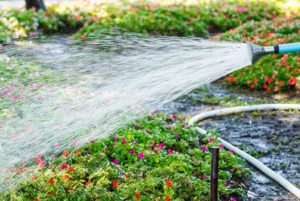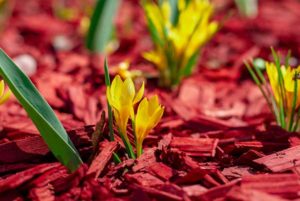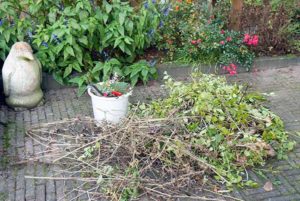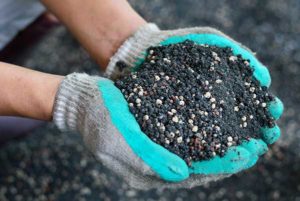Summer Plant Health Care Tips
Summertime is an exciting time for gardeners and anyone wanting to cultivate outdoor plants. Summer weather brings challenges of extreme heat, scorching sun, drought, and pests. These difficulties require different care methods to keep your plants healthy. Here are a few techniques and tips to help your plants thrive in the summer weather, so you can enjoy the gorgeous results of your efforts.
Watering Amounts Vary For Each Plant Type
 Adequate water is one of the primary concerns of summer plant care. Both too little and too much water are detrimental to the health of your plants all year round, but are of special importance in summer. Hot temperatures and bright sunlight work together to quickly evaporate water and dry out the soil. This increases the need for hand watering during hot summer months. A good general strategy is to provide deep watering two or three times per week.
Adequate water is one of the primary concerns of summer plant care. Both too little and too much water are detrimental to the health of your plants all year round, but are of special importance in summer. Hot temperatures and bright sunlight work together to quickly evaporate water and dry out the soil. This increases the need for hand watering during hot summer months. A good general strategy is to provide deep watering two or three times per week.
Remember that not all plants need the same amount of water, so it’s best to research the correct watering methods for each species of plant you grow. Some may require watering only once per week while others need more water and should be checked daily. Pay attention to the rain as that will affect how often you must water as well. The amount required depends on the type of plant, its size, whether it is in a container and the amount of light, heat, humidity, and airflow it receives.

Some plants, such as ferns, prefer high levels of humidity. If you need to increase the level of humidity to keep your plants healthy, try filling a dish with pebbles and water and place your potted plant on top of it for added moisture, or try misting your plants with a spray bottle.
Finally, try to water your plants in the morning. Evening watering may contribute to fungus growth due to the additional warmth and moisture from the summer day. Watering during the hottest part of the day is often ineffective as most of the water leeches off into the soil instead of reaching your plants. You can conserve water and provide better plant care by structuring your watering schedule in the morning.
Mulch Has Several Benefits For Your Plants

One of the biggest advantages of using mulch is that it helps soil retain moisture. This is a wonderful benefit during periods of drought. You can water less frequently since the moisture stays where it is needed instead of evaporating. Mulch also regulates the temperature of the soil, helping roots stay cool during hot summer weather.
The presence of mulch is great for deterring weed growth and access to sunlight. Mulching will save you the time and effort of eliminating the need to pull weeds that absorb nutrients and crowd your plants.
Mulches made from organic materials, like wood or compost, release nutrients into the soil when it begins to decompose. This improves the quality of the soil and aids plant growth and health. Mulch can even break up clay soils to allow greater air circulation and water absorption.
Prune Regularly and Properly

Hot and dry conditions can stress a plant and cause leaves to look wilted or develop discoloration. These signs are often mistaken for a disease or signs of a dying dying plant. Avoid cutting away healthy, but stressed areas by waiting for normal temperatures to do any pruning. The right approach to summer pruning can encourage better crop yields and gorgeous displays of blooms from flowers and ornamental plants.
Plant Pest Control Is Plant Health
Animals and insects can do a number on your plants. Take action to prevent lawn pests where possible and get rid of any that show up at the first signs of their presence. Different types of pests can be dealt with in different ways, so research the correct methods to make sure you get to the root of the problem and handle it effectively and efficiently. The wrong techniques may result in recurring infestations.

For insects, the first step is to keep your plants as healthy as possible so they can resist minor infestations. Do a routine inspection to discover signs of damage like holes in leaves and dying branches. If you notice small numbers of insects, pick them off by hand or trim away the affected area of the plant. Plant coverings are also effective for keeping some insects away, but this solution is not practical for larger areas When you have a widespread pest issue, a pesticide could solve the problem.
If you use an insecticide spray, choose your products carefully. Some kill good insects like butterflies and bees in addition to pests and can have a negative impact on the environment. Always read the instructions carefully before applying any insecticides. Calling in a professional is the best way to eliminate severe infestations and to learn which products are safe and effective.
Counteracting Extreme Heat and Heat Waves
Extreme heat and excessive sunlight can damage your outdoor plants when exposed to prolonged high temperatures, can even sunburn them. Young plants are more susceptible to damage than established plants. Carefully plan out your garden and place your plants in areas where they receive some shade. If natural shade isn’t available, consider using a tarp, shade cloth, or row covering to provide temporary relief from the sun.
A thick layer of mulch can also provide a buffer against extreme temperatures and help cool plants. When you water, avoid wetting the leaves of your plants as this can actually increase the likelihood of sun damage. Focus the water at the base of the plant to reach the roots.
Too little water and too much heat can cause stress that results in dropped leaves and flowers, pale or discolored leaves, and wilting. Brown and yellow patches on plant stems and leaves are other indications of stress.
When you notice these signs, take action to undo the damage before your plant fails. Required action could be more frequent watering or providing shade during the hottest part of the day. Schedule plant maintenance at appropriate times to encourage plant health and avoid further damage. During heat waves, do not fertilize, repot, or prune plants as this will cause added stress.
Feeding and Nutrients

Only apply fertilizers and nutrients at the proper times, usually during moderate temperatures on less humid days. Extreme weather can put your plants into survival mode where they are unable to absorb added nutrients. Wait until the temperature cools so your plants can properly absorb and benefit from the food you give them.
You don’t need to spend every free moment you have in your garden to keep your plants healthy. The best approach for overcoming heat, water shortages, and increased number of bothersome pests is preparation. Have a plan to care for each type of plant you are growing. Remember that not all thrive under the same conditions, so learn what each variety needs and how to recognize signs of stress that require additional care. When you know what each plant requires, you can take steps in advance to help your plants survive adverse weather conditions. Keeping to your routine maintenance will keep them healthy and beautiful.
Keeping Your Plants Healthy in the Summer
We would love to help you keep your plants and flowers healthy. Contact us today for a Free Estimate and let a RYAN Plant Health Care expert help with your plant and flower needs!









